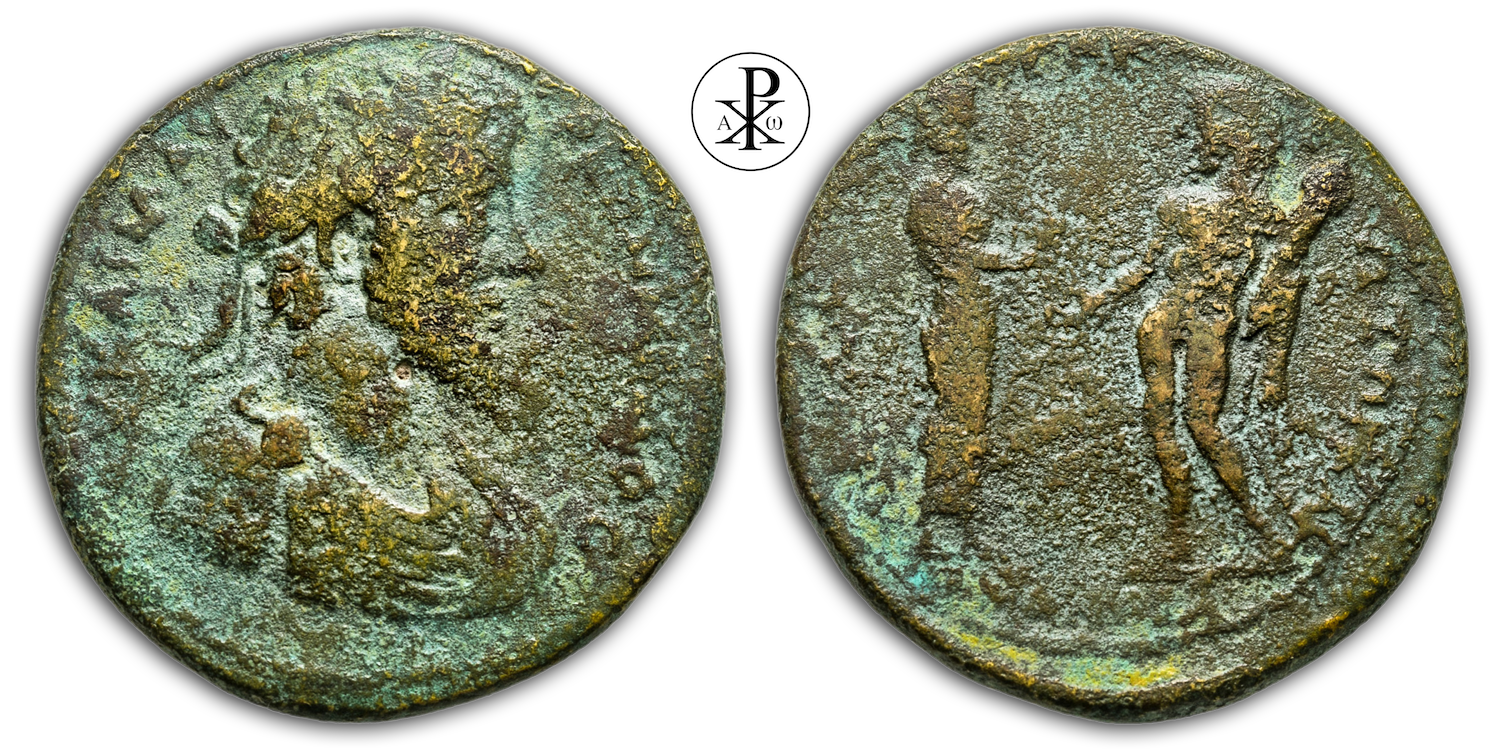Imperator Caesar Marcus Aurelius Commodus Antoninus Augustus
Reign: Commodus
Mint: Laodicea ad Lycum, Phrygia
Date: 184/190 AD
Nominal: Bronze
Material: AE
Diameter: 36mm
Weight: 28.15g
Reference: RPC IV.2 9216 (#2 this coin)
RPC Online: https://rpc.ashmus.ox.ac.uk/coins/4/9216
Rare: Specimens 2 (1 in the core collections)
Provenance: Savoca Numismatik Munich, Germany (Auction 166, Lot 1041)
Pedigree: –
Obverse: Laureate-headed bust of Commodus wearing cuirass and paludamentum, right, seen from front
Inscription: ΑΥ ΚΑΙ Μ ΑVΡ ΚοΜΜοΔοϹ
Translation: Autokrator Kaisaros Marcos Aurelios Kommodos
Translation: Imperator Caesar Marcus Aurelius Commodus
Reverse: To left, Zeus of Laodicea standing, right, holding long sceptre and eagle; to nude Heracles (bearded) standing, left, holding club and lion skin; both clasping hands
Inscription: ΛΑΟΔΙΚƐΩΝ ΚΑΙ ΗΡΑΚΛƐΩΤΩΝ ΟΜΟΝΟΙΑ
Translation: Laodikeon kai (H)erakleoton (H)omonia
Translation: [City of] Laodicea [ad Lycum] and [City of] Heraclea [Salbace] in harmony
Comment: Laodikeia on the Lykos (Latin Laodicea ad Lycum) was an ancient city in Phrygia, 6 km north of present-day Denizli and 10 km south of Hierapolis, on the Lykos River (today Çürüksu Çayı), a tributary of the Meander. Instead of an older settlement called Diospolis, Laodikeia was founded by Antiochos II between 261 and 253 BC and named after his wife Laodike. In Roman times, the city was the centre of a judicial district (conventus) of the province of Asia and was considered an economic centre. Marcus Tullius Cicero, in his year as proconsul in Cilicia in 51/50 BC, was responsible, among other things, for the jurisdiction of the eight judicial districts of his province. For this purpose he stayed in Laodikeia from 13 February to 15 May of the year 50 BC, having arrived on 11 February. In addition, he was already in Laodikea in 51 BC on 30 July (he uses the Praecaesarian form “Quintilis”) to take up his duties. Numerous letters to friends have survived from this time, dating from 20 February to the beginning of May 50 BC.
In the 1st century AD, Laodikea was twice severely devastated by earthquakes, under the emperors Tiberius and Nero, but recovered on its own. In Roman times, Laodikeia was an important cotton growing area. Laodikeia is close (8 km) to the thermal baths of Hierapolis (now Pamukkale). Thus, the city lived on spa guests and pilgrims (who considered the healing waters sacred) and became very rich. Due to the special composition of the thermal water of Pamukkale, a special eye ointment was produced in Laodikeia. A certain red plant root could be diluted with this water and then turn black fabrics purple. Thus, more and more purple fabrics in the Roman Empire were made in Laodikeia, for example the purple sails of Cleopatra. The elaborate dyeing of fabrics with Syrian purple snails had been given an alternative, so that Laodikeia soon became the purple fabric factory of the Roman Empire. At the beginning of the 4th century, Laodikeia was the metropolis of the province of Phrygia Pakatiane. In 363-364 AD, the Council of Laodicea took place there. After an earthquake in 494 AD, the city lost its importance. In the Middle Byzantine period, Laodicea belonged to Thrakesion.
Laodikeia is situated on a flat hill, on the north-western slope of which there were two theatres, parts of the rows of seats of which are still preserved. To the south of the city was a large stadium built at the time of Vespasian; a building nearby was probably a bath complex. A nymphaeum built in the 3rd century in the centre of the city was probably the terminus of a water conduit leading from the south to Laodikeia. Excavations by the University of Denizli under the direction of Celal Şimşek uncovered an early Christian church. Remains of mosaics and frescoes were found on the 2000 square metre floor space, as well as coins dating to the early 4th century. A baptismal font embedded in the floor with steps on two sides made mass baptisms possible. Excavation and securing work on adjacent buildings (Tempe A) was still ongoing in 2017.
On the reverse of this provincial bronze, the alliance between the cities of Laodicea ad Lycum and Heraclea Salbace can not only be read from the legend – the alliance of the two cities is also illustrated pictorially. On the reverse, Zeus, city god of Laodicea, and Heracles (synonym of the city of Heraclea) shake hands in harmony. The ancient city of Heraclea was located about 30km west of Laodicea.
